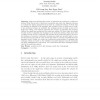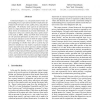44 search results - page 7 / 9 » How to Securely Break into RBAC: The BTG-RBAC Model |
PKC
2007
Springer
14 years 1 months ago
2007
Springer
: This paper addresses the security of optimistic fair exchange in a multi-user setting. While the security of public key encryption and public key signature schemes in a single-us...
SP
2006
IEEE
14 years 1 months ago
2006
IEEE
Contextual integrity is a conceptual framework for understanding privacy expectations and their implications developed in the literature on law, public policy, and political philo...
SOUPS
2010
ACM
13 years 11 months ago
2010
ACM
Home computer systems are frequently insecure because they are administered by untrained, unskilled users. The rise of botnets has amplified this problem; attackers can compromis...
CCS
2010
ACM
13 years 7 months ago
2010
ACM
We show in this paper how several proposed Physical Unclonable Functions (PUFs) can be broken by numerical modeling attacks. Given a set of challenge-response pairs (CRPs) of a PU...
SACMAT
2009
ACM
14 years 2 months ago
2009
ACM
Traditional access control models, such as Role-Based Access Control (RBAC), do not take into account contextual information, such as location and time, for making access decision...


